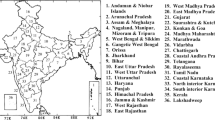Abstract
Air Pollution is one of the main contaminants in industrial cities like Tehran, but it depends on many factors. One of the most important factors is wind field. Wind field shows how the pollutants transfer by convective mechanism. Tehran as the most polluted city of Iran (or may be Middle East) locates in a mountainous situation and is surrounded from two sides by high mountains and from two sides by desert. Therefore, the topography of Greater Tehran Area is so complex and needs more attention. We have studied the air pollution in Tehran from this point of view in this paper and used MEMO software for simulation of wind field in this area. The results show good agreement with experimental observations and show stronger wind from south to north and west-south to east-north in days and then night in reverse direction. It causes that the pollutants remain at urban area and the concentrations of pollutants reach to a serious level.
Similar content being viewed by others
References
Municipality of Tehran, Japan International Co-operation Agency, and Air Quality Control Company, The Study on an Integrated Master Plan for Air Pollution Control in the Greater Tehran Area in the Islamic Republic of Iran, Interim Report, Ed.: Japan Weather Association and UNICO International Corporation, Tehran, Iran, (1997).
AQCC, SWECO International, SMHI, and MTC, Tehran Transport Emissions Reduction Project (TERP) - Main Report, Tehran, Iran, (1997).
Moussiopoulos, N., MEMO - A Nonhydrostatic Mesoscale Model, in, The EUMAC Zooming Model, edited by: Moussiopoulos, N., Model Structure and Applications, EUROTRAC Inter. Sci. Sec. Garmisch-Partenkirchen, pp.7–21, (1994).
Moussiopoulos N., Sahm P., Kessler Ch., Numerical Simulation of Photochemical Smog Formation in Athens, Greece - A Case Study, Atmos. Environ., 29, No. 24, pp. 3619–3632, (1995).
Seinfeld, J.H., Pandis, S.N., Atmospheric Chemistry and Physics from Air Pollution to Climate Change, John Wiley & Sons Inc, (1998).
Environmental System Research Institute, Inc., ARC/INFO Version 7.0.3, 380 New York Street, Redlands, CA USA 92373, (1993).
IRIMO: Annual Report of IRIMO Data Processing Centre, Tehran, Iran, (1996).
Badii, Kh., Dabir, B., Alaie, S.M., N.S., Moussiopoulos N.S., “The Study of Atmospheric Stability Classes in the Greater Tehran Area During Autumn Season,” 4th International & 8th Annual Conference of Iranian Society of Mechanical Engineers (ISME2000), Tehran, Iran, to be presented, (2000).
Author information
Authors and Affiliations
Rights and permissions
About this article
Cite this article
Badii, K., Dabir, B., Moussiopoulos, N.S. et al. Wind field in greater tehran area (GTA) in autumn season. J. of Therm. Sci. 9, 205–210 (2000). https://doi.org/10.1007/s11630-000-0052-8
Issue Date:
DOI: https://doi.org/10.1007/s11630-000-0052-8




